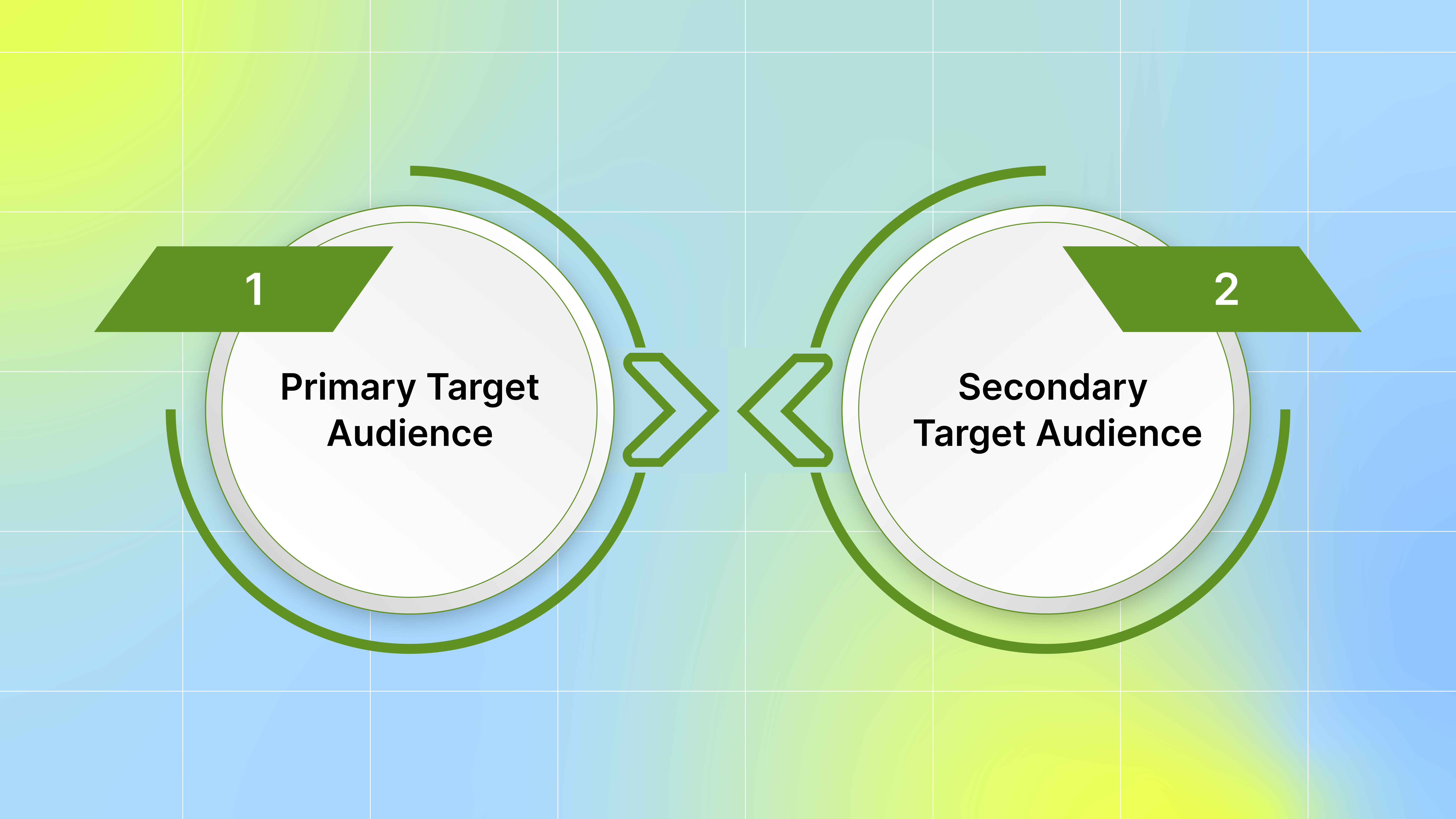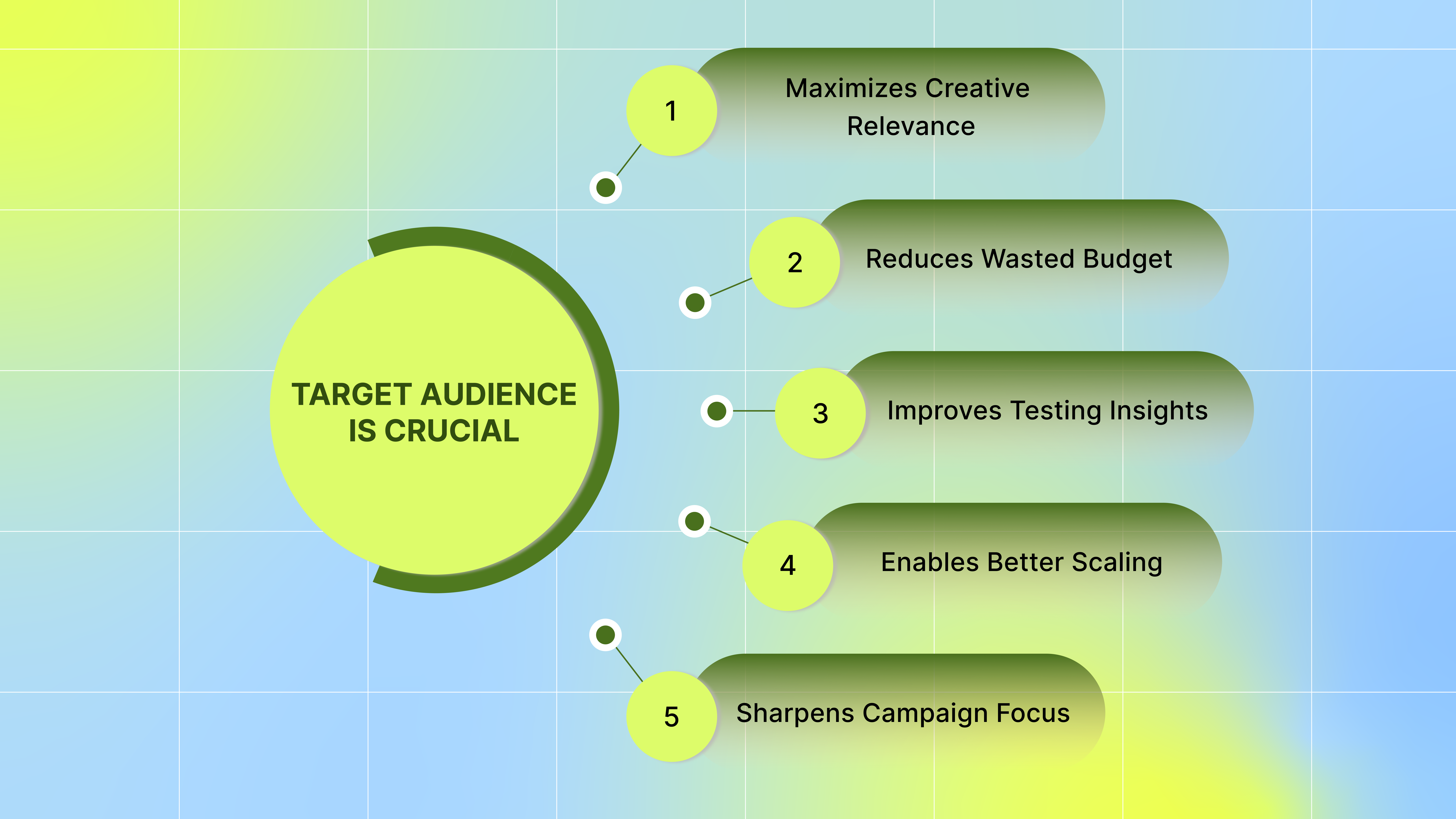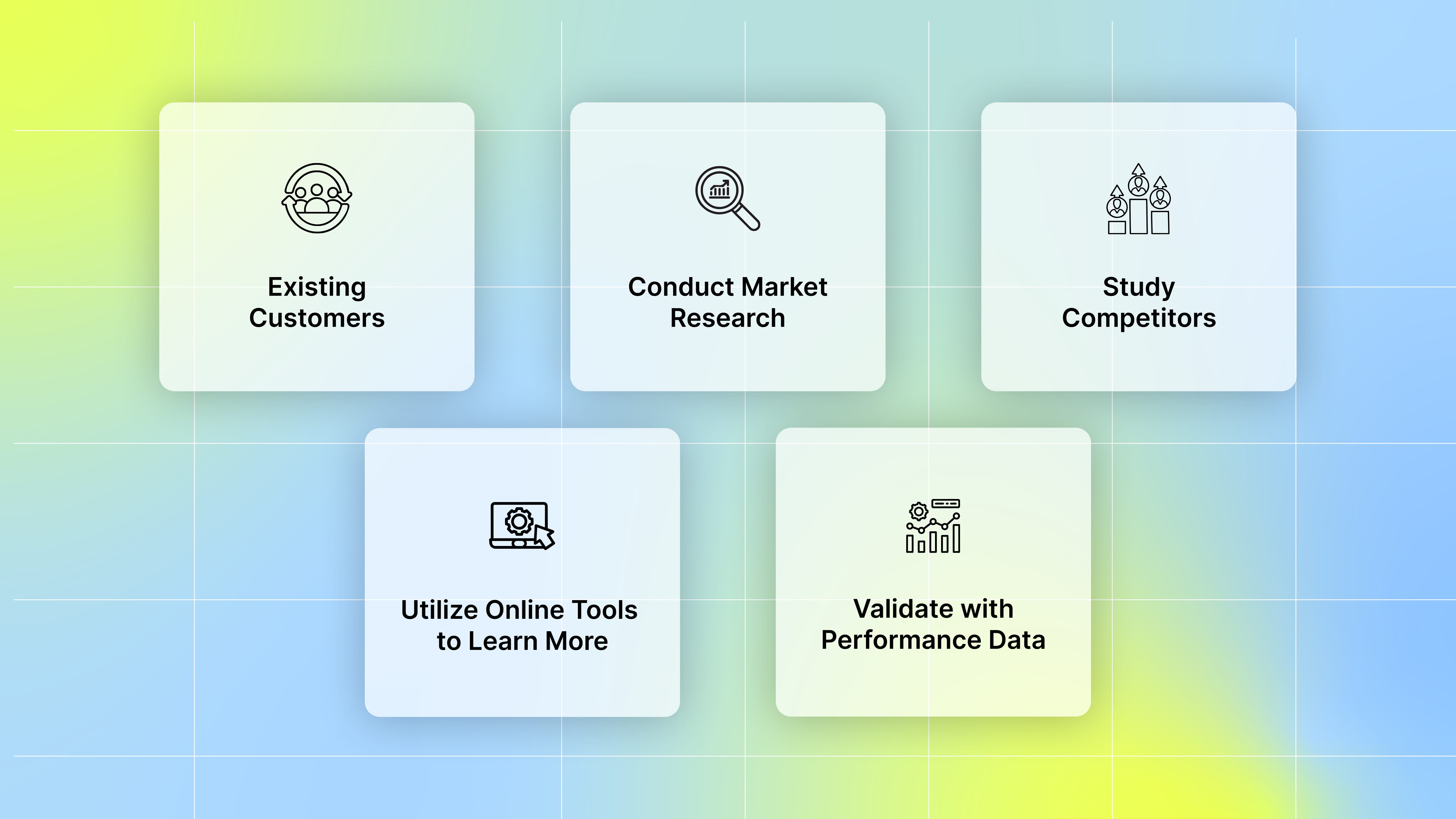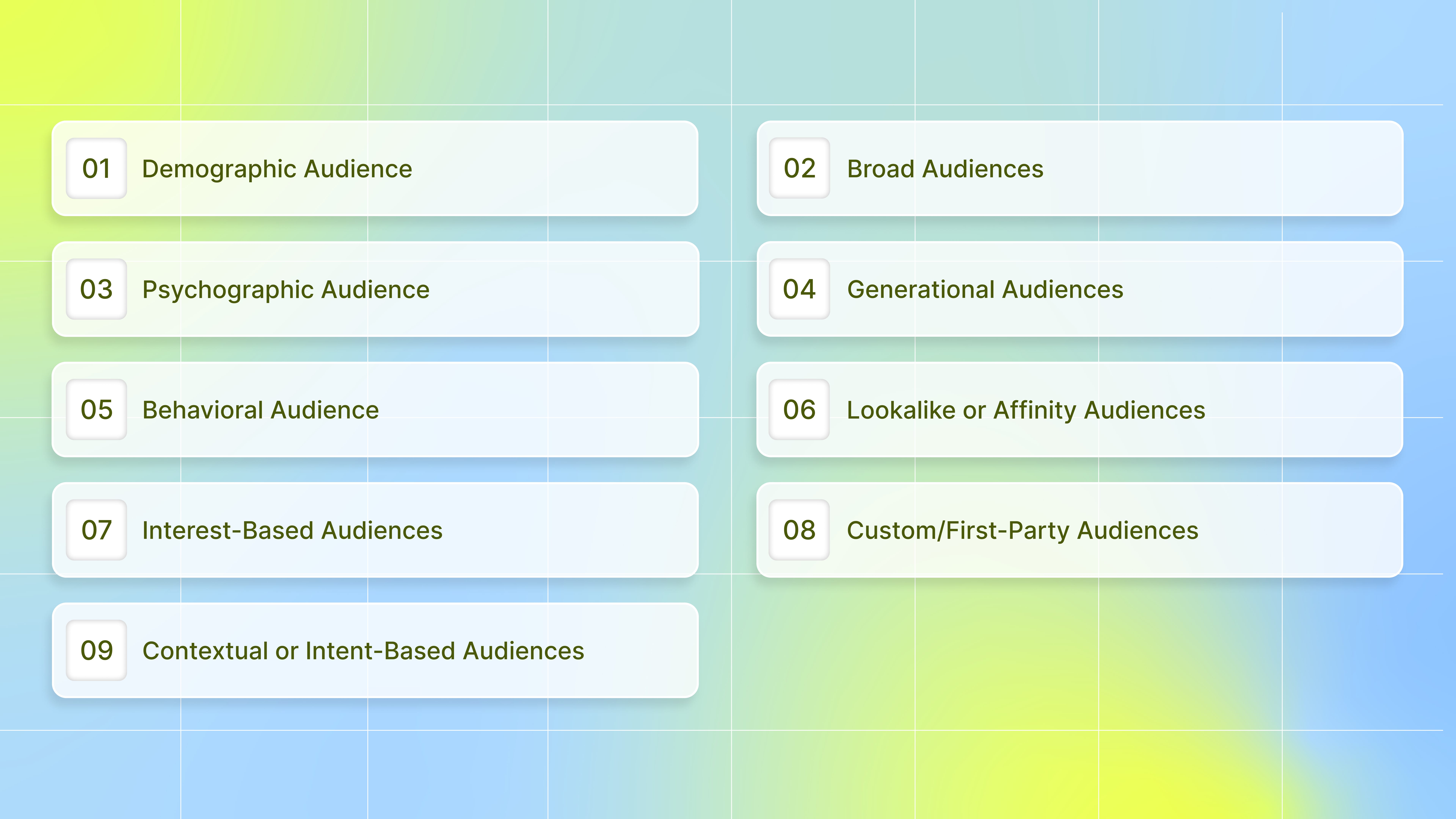The Ultimate Guide to Understanding Different Types of Target Audiences
Some ad creatives drive massive installs or purchases, while others barely make an impact. In user acquisition, success isn’t just about producing visually appealing ads; it’s about understanding who those ads are designed to reach. The key lies in identifying different types of target audiences and aligning your creatives with their unique preferences and behaviors.
When your creative directly resonates with the right audience segment, performance soars, ROAS climbs, acquisition costs drop, and campaigns scale efficiently. Whether you’re testing new ad formats, refining messaging, or optimizing your creative strategy, audience‑specific ads are what transform a good campaign into a great one.
So, if you are still spending on creatives without knowing who they truly speak to? This blog will explore the main types of target audiences, from behavioral to psychographic, and show how understanding them can elevate your creative strategy for sustained growth.
Key Takeaways
Identifying the right target audience is the foundation of successful user acquisition, shaping how your creatives connect, convert, and scale.
Different audience types, such as demographic, psychographic, behavioral, and contextual, enable precision-driven creative messaging tailored to user motivations.
Audience research methods, including user data analysis, market research, competitive intelligence, and performance validation, ensure your creatives hit the right mark.
Creatives perform better when they're aligned with audience intent, driving higher installs, purchases, and ROAS while reducing wasted spend.
Real brand examples prove that combining smart segmentation with audience-specific creatives unlocks massive gains in campaign efficiency and results.
What’s a Target Audience?
A target audience is the specific group of people your marketing and advertising efforts are designed to reach. The segment is most likely to take meaningful action, such as installing an app, subscribing, or purchasing a product. It’s the foundation for every creative, message, and channel decision you make.
In user acquisition, that means crafting ads that attract users by speaking directly to your most relevant audiences.
Here are the two key audience types:

1. Primary Target Audience
This is your core group, the people who are most likely to take action (install your game, buy your product, subscribe to your app). They have the intent, capacity, and fit to convert. Your creatives should be purpose-built for this group, aligning messaging and visuals to their preferences, pain points, and behaviors.
2. Secondary Target Audience
This group isn’t your top priority, but it still matters. They may not convert immediately as reliably as your primary audience, but they share similarities or interests that are adjacent to yours. They might be influenced by your messaging or serve as a receptive pool when you scale. Your creative strategy should be flexible enough to appeal to them without diluting your primary audience's focus.
To go a step deeper, let’s clarify how a target audience differs from a target market.
Also Read: Mobile Ad Targeting Best Practices for 2025
Target Market vs Target Audience - What's the Difference?
The target market and target audience serve different purposes in user acquisition and creative strategy. Understanding the distinction helps you build stronger campaigns and deliver creatives that truly convert.
Breadth: A target market is the broad pool of potential users you could sell to (all those who might find value in your app or product). A target audience is a narrow segment within that market you actively tailor creatives and campaigns to reach.
Strategy vs. Execution: The target market shapes your high‑level positioning, product roadmap, and market approach. The target audience guides your ad-level tactics, which include the creatives, messaging, hooks, and formats you test.
Quantity: You may have a single overall target market, but multiple target audiences for different campaigns. Each audience gets its own creative angle, testing plan, and performance analysis.
Creative Focus: The target market describes who your offering is for, generally. The target audience directly influences how you craft your ads, everything from visual style and tone to hooks, CTAs, and ad formats that resonate with their intent.
Conversion Potential: A target audience typically consists of people more likely to convert because they match specific behavior or interest criteria. The target market may include broader groups less tightly aligned to those conversion triggers.
In short, your target market defines who your product is for, while your target audience determines how you communicate that through your creatives. Distinguishing the two ensures your campaigns are both strategically aligned and executionally effective.
Understanding the distinction is just the beginning. Now, let’s explore why pinpointing your target audience is essential for creative success and campaign efficiency.
Why Identifying Your Target Audience is Crucial?
When you know who you’re talking to, your creatives become sharper, your spend gets smarter, and your campaigns start converting more often. Without that clarity, your ads run the risk of speaking to the void.
Here are key reasons why defining your target audience matters:

1. Maximizes creative relevance
Knowing your audience enables you to craft visuals, hooks, and narratives that resonate with their interests, goals, and emotional triggers. Instead of casting a wide net, you deliver personalized messaging that speaks directly to what matters most to them.
2. Reduces wasted budget
Precise targeting helps you avoid spending on impressions that don’t convert. When creatives are shown to uninterested or mismatched users, performance tanks. By narrowing your audience, you ensure your budget supports the segments most likely to take action, improving ROAS.
3. Improves testing insights
Creative testing becomes more meaningful when audience variables are controlled. You can isolate which creative elements, like CTA, headline, or visual style, perform best for specific audience groups, allowing for smarter iteration and optimization.
4. Enables better scaling
Once you identify which segments respond best to your creatives, you can confidently scale those campaigns. Knowing your top-performing audiences allows you to replicate success across lookalikes, expand reach without guessing, and maintain efficiency as you grow.
5. Sharpens campaign focus
Clear audience definitions help guide tactical decisions, such as which platforms to prioritize, which formats to test, and even which time slots or geographic areas to target. This keeps your UA campaigns aligned with both strategic goals and creative direction, ensuring consistent performance.
Once you understand why defining your target audience is important, the next step is learning how to identify and validate them effectively.
How to Identify Your Target Audience?
Identifying your target audiences doesn’t have to be guesswork. With the right process, you can identify precisely who your creatives should target and optimize your media spend and creative ROI. Below are a few ways to uncover and validate your audiences:

1. Search Through Your Existing Customers
Begin with your current users, those who’ve already installed, purchased your other apps or products. Export their demographic data (age, gender, location), behavioral metrics (session frequency, feature format), conversion paths, and creatives. Use clustering tools or cohort analysis to spot patterns and common traits among your top converters. Identify common characteristics among your top‑converting users to form a core audience baseline.
Why it matters: This gives you a grounded starting point based on performance data rather than assumptions.
Example: Suppose 40 % of your highest LTV users are aged 25–34 and regularly use night modes. Your creatives might lean into visuals and language that appeal to that age group and usage habit.
2. Conduct Market Research
Reach beyond your user base by conducting surveys, interviews, and focus groups to surface motivations, habits, and unmet needs in prospective audiences. Combine these qualitative insights with industry reports and secondary data to validate themes. You’ll then form hypotheses for creative messaging that speaks to those latent desires, opening doors to segments you may not even have known existed.
Why it matters: You’ll uncover new segments or motivations your internal data may not reflect yet, especially useful for creative ideation and expanding reach.
Example: You may discover that a segment you haven’t targeted yet values “simplicity over features,” inspiring minimalist creatives and messaging aimed at that mindset.
3. Study Competitors
Scan your competitors ads across their channels. Watch for repeated creative patterns, messaging styles, or hook structures that appear to be effective (based on frequency, engagement, or longevity). Utilize tools such as ad libraries or creative intelligence platforms to aggregate this insight.
Why it matters: Their testing reveals what resonates in the market, providing shortcuts to creative angles and audience ideas without starting from scratch.
Example: You may see a competitor frequently testing “limited-time offer” hooks in a specific geographic area. This suggests that urgency messaging might resonate with that region.
4. Utilize Online Tools to Learn More
Tap into analytics and audience insight tools to scale your discovery. Pull reports from Google Analytics, Google Trends, or social ad platforms. These tools help you make informed decisions about audience segments before investing significant budgets in creative tests.
Why it matters: These tools help you identify which segments show engagement, providing data-backed hypotheses for targeted creative approaches.
Example: If Google Trends shows rising interest in “mindful lifestyle” in certain markets, you can test creatives that align with that theme for that region.
5. Validate with Performance Data
Launch small-scale campaigns or creative A/B tests across different audience segments. Measure performance metrics, install rates, purchase conversions, and ROAS for each segment. Use the results to refine which audiences get a full-budget launch.
Why it matters: Only this performance data can confirm whether a segment truly responds to your creatives as predicted.
Example: You test the same video creative across Segment A and Segment B. Segment A’s install rate is 2× higher, while Segment B’s ROAS is flat, so you scale A and rework creative messaging for B.
Once you’ve identified who you're targeting, the next step is to understand the types of audiences that can shape your creative strategy and drive immediate performance.
Types of Target Audiences
Understanding the types of target audiences helps UA teams craft creatives that not only capture attention but also drive instant actions, installs, purchases, and subscriptions. Knowing these audience types ensures your creative decisions are precise, performance-driven, and scalable.
Here are the key types of target audiences you should consider:

1. Demographic Audience
These are audiences segmented by measurable attributes, such as age, gender, income, education level, or job title. Demographics help you anchor creatives to language, tone, and offers tailored to a user’s life stage or social status.
For example, you run two video creatives: one with energetic visuals and slang targeting users aged 8–24, and another with more explanatory visuals and benefits targeting users aged 50. You aim to see which demographic converts better.
2. Broad Audiences
A broad audience covers your general market with minimal segmentation. While it lacks specificity, it’s useful for early creative validation and data gathering. While this approach lacks specificity, it lets you test baseline creative performance before narrowing down.
For example, you run a generic video creative to a wide user base across various interests and regions to gather initial engagement benchmarks before narrowing down the segmentation.
3. Psychographic Audience
This type targets users based on attitudes, values, interests, lifestyles, and personality traits. Psychographics delve deeper than surface traits. They help your creative messaging resonate with why people act.
For example, A creative emphasizing competitive challenges and status may connect with “hardcore competitors,” while another ad focusing on relaxation or social features might appeal to “casual users” seeking less intense experiences.
4. Generational Audiences
Segmenting by generation (Gen Z, Millennials, Gen X, etc.) helps align creatives to deeply rooted preferences, values, and digital habits. Each generation responds differently to visuals, tone, and storytelling.
For example, a fast-paced, short-form creative featuring social proof and meme culture may appeal more to Gen Z than to Gen X, who may prefer messaging that focuses on functional benefits.
5. Behavioral Audience
These audiences are defined by user actions, including purchase history, usage behavior, repeat buying, churn, and engagement levels. Creatives can be mapped to a journey stage or observed behavior.
For example, for users who have added items to their cart but haven’t checked out, show a creative with scarcity messaging (“Only 24 hours left!”). For lapsed users, show a “We miss you” or new feature preview creative.
6. Lookalike or Affinity Audiences
These audiences are modeled after your highest-converting users or those with similar interests and behaviors. Creatives for these groups should mirror the messaging, hooks, and visuals that performed best with your core audience. This approach helps scale reach efficiently while maintaining strong creative‑audience alignment.
For example, if your top converters respond well to a creative that features lifestyle visuals + a specific hook, use that same format for lookalike audiences and test slight variations to maintain performance.
7. Interest-Based Audiences
This segmentation is driven by passions, hobbies, and content engagement patterns. Creatives for interested audiences lean heavily into visual or thematic hooks aligned with those passions.
For example, for an audience interested in fitness, open with a montage of workout images or community scenes rather than a generic brand story. So the creative instantly resonates.
8. Custom/First-Party Audiences
Audiences drawn from your own data, CRM, app usage, and past converters. Creatives can be deeply personalized because you know their history.
For example, A user who installed but never purchased may see a creative promoting a first-time discount; a high-engagement user sees messaging about premium features, cross-sells, or subscription upgrades.
9. Contextual or Intent-Based Audiences
Users engaging with related content or showing interest in similar topics. Good for aligning creative messaging with current user intent. Instead of relying on their past behaviors or profiles, you meet them in the moment when their interests align with your creative message.
For example, someone browsing similar products might see an ad with messaging like “Best price today only” or “Top rated + free shipping,” nudging their decision with a clear call to action.
Once you understand the different types of target audiences, the next step is seeing how real brands apply these insights to craft high-performing creatives.
Also Read: How to Build a Competitor Dashboard for Insights
Examples From Real-life Brands
Real brands have seen transformative results by tailoring creatives to the right target audiences. These examples highlight how aligning messaging with specific segments drives installs, purchases, and performance.
Here are a few examples:
1. Faye (Children’s Apparel Brand)
Challenge: Broad targeting was driving many clicks, but low-conversion creative messaging was generic and didn’t resonate deeply.
Approach: The team used an AI persona generator to build narrow audience segments based on interests. They then created creatives tailored to those interests, layering those imaginative hooks over their apparel visuals.
Outcome: Impressions soared by 367% and clicks rose by 253%, while CTR remained comparable to prior top audiences. Faye scaled into new creative-audience combinations without a major performance dropoff.
2. KlientBoost
A firm serving retailers and DTC brands was facing a seasonal slump. Their campaigns were generating interest, but they struggled to convert that into high‑quality leads. Their ad spend was not efficient, and creative messaging was under‑optimized for their ideal targets.
Solution & Approach
KlientBoost refined targeting by tightening LinkedIn account-based audiences and narrowing Google/Bing ad sets, ensuring creatives were aligned more closely with decision makers.
They refreshed ad copy and visuals, emphasizing value propositions that suited those audiences (e.g., pain relief, ROI proof).
Landing pages were revised to align with creative messaging and enhance the conversion flow.
Results & Impact
Total leads increased by 63 % (133 → 217)
Cost per lead (CPL) dropped ~20 %
Google-sourced leads rose by 67 %
LinkedIn CPL decreased by 40 %
Conclusion
Understanding your target audience is the foundation of effective user acquisition. By segmenting users demographically, behaviorally, or psychographically, you can craft creatives that resonate, drive installs or purchases, and improve ROAS. Identifying and validating audience types enables you to make more informed creative decisions, scale efficiently, and minimize wasted ad spend.
If you want more detailed creative insights, Segwise acts as your AI-powered partner in making informed creative decisions. It provides tag-level performance optimization, so you can instantly see which creative elements, themes, and formats drive results across all your campaigns and audience segments.
Moreover, by combining learnings from creative tags, briefs, and audience response data, Segwise helps you iterate in the right direction, mapping which creative themes resonate with your audience. Over time, you can evolve a perfectly matched creative for each segment, not by guesswork but by data-backed refinement.
Want to start targeting your creatives smarter from Day 1? Try Segwise with a free trial and begin uncovering which ads truly speak to which audiences.
FAQs
1. How often should I revisit or update my target audiences?
Frequently. As performance data flows in and market dynamics evolve (e.g., creative fatigue, new trends), you should re-validate segments and refine creative audience mapping to stay optimized.
2. How do I choose which audience types to test first?
Start with what your existing data supports (demographic, behavior). Then layer in psychographic or intent audiences as you gain confidence. Always validate with small-scale creative tests before scaling.
3. Is intent‑based (or contextual) targeting still effective in privacy‑first environments?
Yes. With privacy changes limiting behavior tracking, intent‑based (e.g., what users are currently viewing or reading) becomes a powerful alternative to reach users mid-decision using creatives that match their current mindset.

Comments
Your comment has been submitted successfully!